History cartoons- causes of World War One
5.0(2)
Card Sorting
1/10
There's no tags or description
Looks like no tags are added yet.
Study Analytics
Name | Mastery | Learn | Test | Matching | Spaced |
|---|
No study sessions yet.
11 Terms
1
New cards
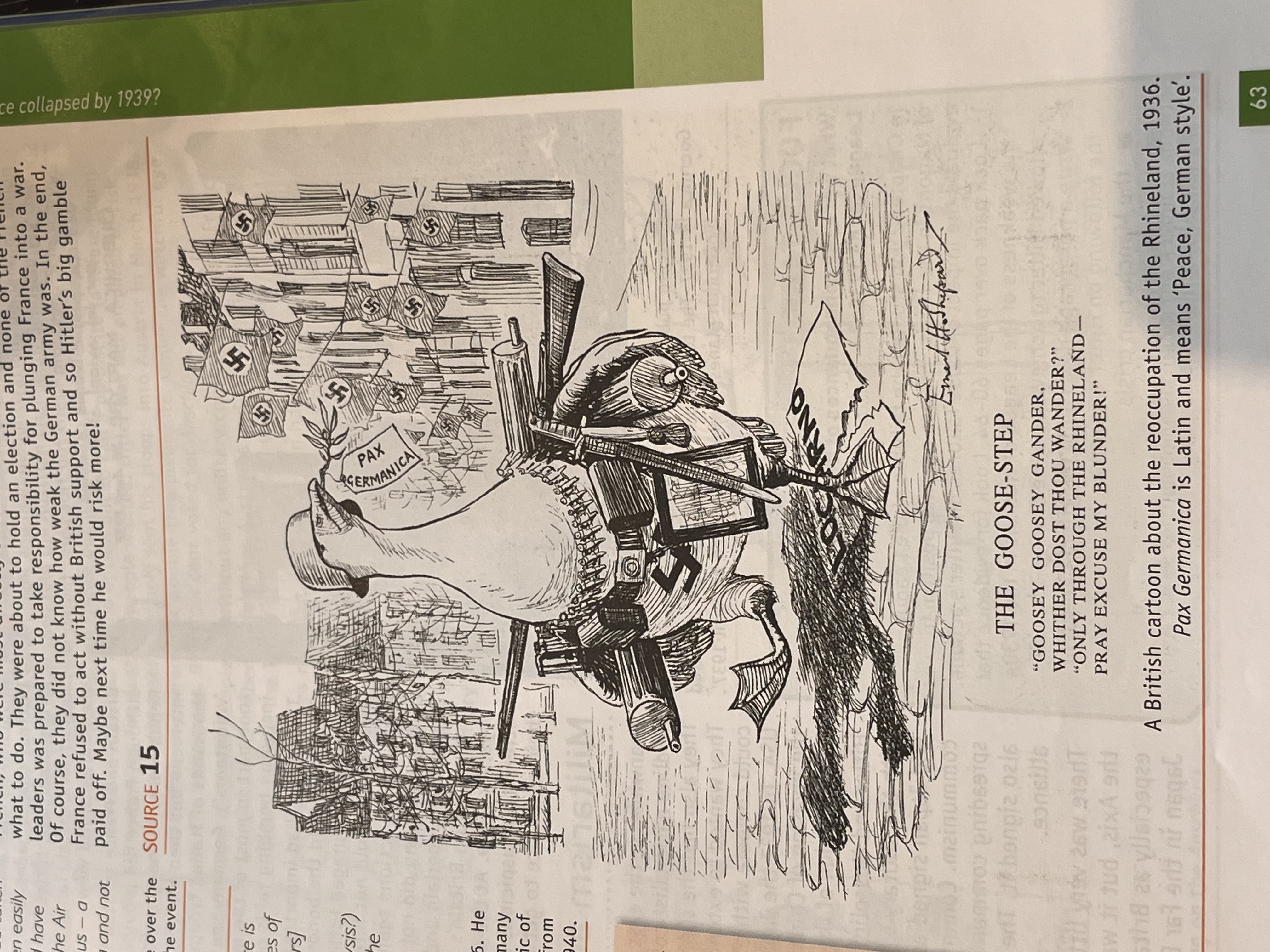
What is the message of this cartoon? (aka what message is the ^^cartoonist^^ trying to portray?)
This cartoon about the reoccupation of the Rhineland was published in 1936, three years before World War II began. It is a primary source because it was written at the time of the event, where Germany went against the Treaty of Versailles and the Locarno Treaties and took over the Rhineland. The terms of the Treaty of Versailles, which were set after World War 1, were extremely harsh. The treaty required Germany to take full blame for the war, pay 6,600 million pounds for the damage of the war, shrink their army, and give up a lot of their land and colonies. Because of this, their union with Austria was not allowed either. One of the biggest disappointments for Germany was shrinking their army because of how powerful their army was before. They were only allowed to have six naval ships, and they were not allowed to have tanks or an air force. Along with this, the Rhineland had to be de-militarized. It was partly because of the harshness of this treaty that Germany took over the Rhineland, which went against the Locarno Treaties. Apart from this, they also wanted their power back the way it was during the time of the Weimar Republic. This cartoon was made to show how Germany broke the Treaty of Versailles, and the Locarno Treaties. These treaties made them agree to give up the Rhineland, as well as other parts of their land. The three main countries that this political cartoon aims to address are Britain, France and Germany. This is because of the fact that this cartoon is directly aimed at Germany, as they were the ones who went against both the Treaty of Versailles and the Locarno Treaties. It also involves Britain and France because France refused to take action against Germany without British support. Since many British people felt that it was Hitler’s right to station his troops in the Rhineland because of the fact that France made a treaty with the USSR which made them promise to protect each other against any attack from Germany, Hitler claimed that Germany was under threat. Britain did not offer France any help to take action against Germany, therefore Hitler got away with taking over the Rhineland. One of Hitler’s main goals was to bring back the same power to Germany as it had during the time of the Weimar Republic, and his first step to doing this was by reoccupying the Rhineland. \n It is important to keep in mind that this source was written from the British point of view. This cartoon was purposely made to insult the Germans. We know this because the goose has a Nazi symbol on it, as well as a bunch of weapons and a helmet, which represent the Nazi soldiers and Hitler. We also know that the Goose represents Germany because there are Nazi flags all over the buildings behind it, which means that it signifies Germany entering the Rhineland. Along with this, the Fascist countries had a reputation of walking differently than regular armies, and therefore are represented by a goose because geese walk with their legs up. In the cartoon, the goose is stepping on the Locarno Treaties and ripping it to shreds while it is holding an olive leaf and a note in its mouth that says “Paz Germanica” which means Peace German Style. This suggests that many British people felt that the Germans were untrustworthy and violent, as they promised to make peace, however they broke this promise and continued to invade and take over territory that they no longer owned. It is important to keep in mind that this source could have been written in a biased perspective; however it still conveys some valid points about World War 2, which were that Germany did not keep their word about the fact that they would stop taking over land and begin to make peace with the rest of the world. We also have reason to believe that it is written with a biased perspective because the Germans would not have written the source in this manner, they would have expressed these ideas differently, in a way that did not put Germany in a negative light. It also conveys the idea that the Treaty of Versailles was extremely harsh and caused Hitler to want to re-gain Germany’s power because of the amount the Treaty of Versailles diminished it, and that is why he took over the Rhineland, Czechoslovakia and Poland, to compensate for the amount of territory Germany lost after World War I.
These ideas are important because they place the blame for the second world war not only on Germany, but also on Britain and France for setting such harsh terms for the treaty, which means that Germany cannot be held fully responsible for World War II, as Hitler reacted only as a normal leader would by trying to get his countries power back by regaining its army and territory. This source is only partially reliable because it is written with a British perspective and is making fun of the Germans, therefore cannot be completely reliable. Obviously since Germany broke the pact between Germany and the League of Nations, Britain was sore and wanted to poke fun at the Germans, and wanted to comment on the way they broke their promise to be peaceful, therefore expressed their ideas in this cartoon. That is why it is only partially reliable and cannot be fully relied upon. It is however, a primary source because of the fact that it was written at the time of the event. This source may be useful to understand the ideas of the British towards the Germans, for example how they felt about the Germans breaking the Locarno Treaties and the Treaty of Versailles. It could also help to understand why the Germans acted in this way and how unreasonable the Treaty of Versailles was. These ideas would also be useful today, because when countries try to settle an issue and decide to sign an agreement, they should know that if the terms are too harsh then the country is bound to break them particularly if they have a strong leader or strong army to help them out. This could also happen in the United Nations, for example if they felt that a certain country’s actions were out of order, they could make them agree to do something, however the terms could be so harsh that the country had no other option but to break them.
These ideas are important because they place the blame for the second world war not only on Germany, but also on Britain and France for setting such harsh terms for the treaty, which means that Germany cannot be held fully responsible for World War II, as Hitler reacted only as a normal leader would by trying to get his countries power back by regaining its army and territory. This source is only partially reliable because it is written with a British perspective and is making fun of the Germans, therefore cannot be completely reliable. Obviously since Germany broke the pact between Germany and the League of Nations, Britain was sore and wanted to poke fun at the Germans, and wanted to comment on the way they broke their promise to be peaceful, therefore expressed their ideas in this cartoon. That is why it is only partially reliable and cannot be fully relied upon. It is however, a primary source because of the fact that it was written at the time of the event. This source may be useful to understand the ideas of the British towards the Germans, for example how they felt about the Germans breaking the Locarno Treaties and the Treaty of Versailles. It could also help to understand why the Germans acted in this way and how unreasonable the Treaty of Versailles was. These ideas would also be useful today, because when countries try to settle an issue and decide to sign an agreement, they should know that if the terms are too harsh then the country is bound to break them particularly if they have a strong leader or strong army to help them out. This could also happen in the United Nations, for example if they felt that a certain country’s actions were out of order, they could make them agree to do something, however the terms could be so harsh that the country had no other option but to break them.
2
New cards
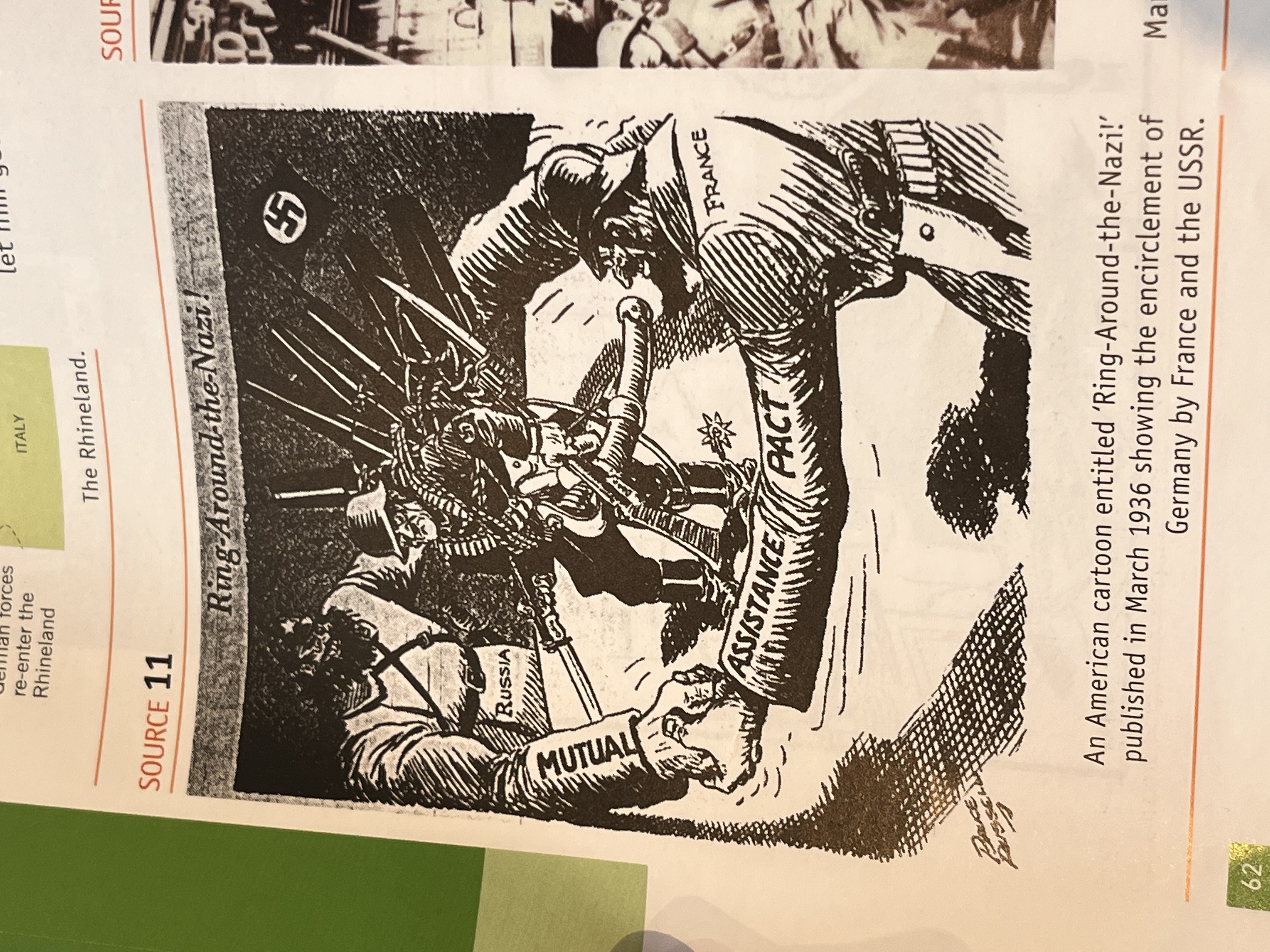
What is the message of this cartoon? (aka what message is the ^^cartoonist^^ trying to portray?)
\
3
New cards
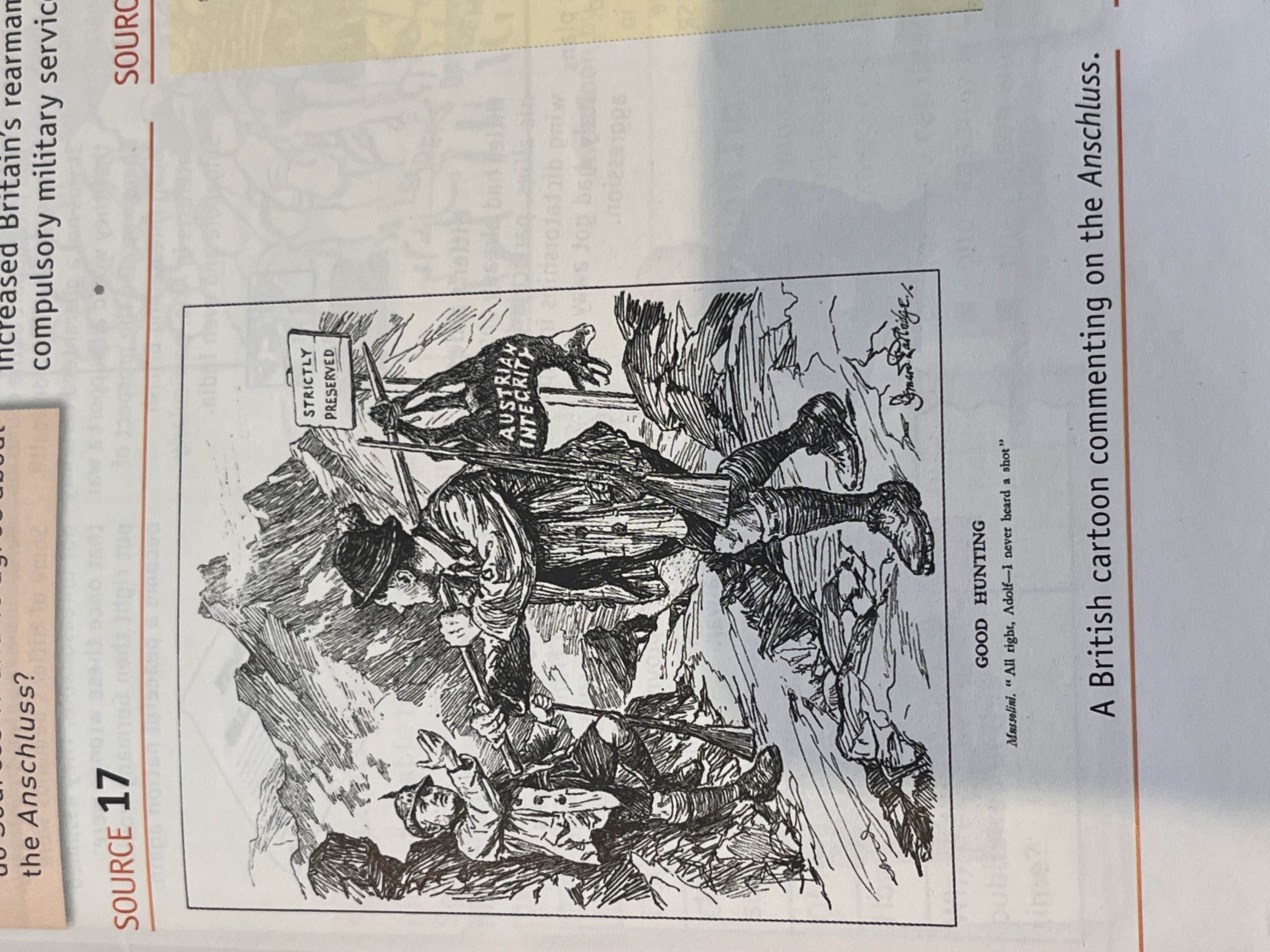
What is the message of this cartoon? (aka what message is the ^^cartoonist^^ trying to portray?)
* Mussolini says: I never heard anything- this is showing his support for Hitler
* Hitler stealing the Austrian integrity
* taking Austria is now legal - good hunting
* critics of Germany taking control of Austria, the Anschluss
* Hitler stealing the Austrian integrity
* taking Austria is now legal - good hunting
* critics of Germany taking control of Austria, the Anschluss
4
New cards
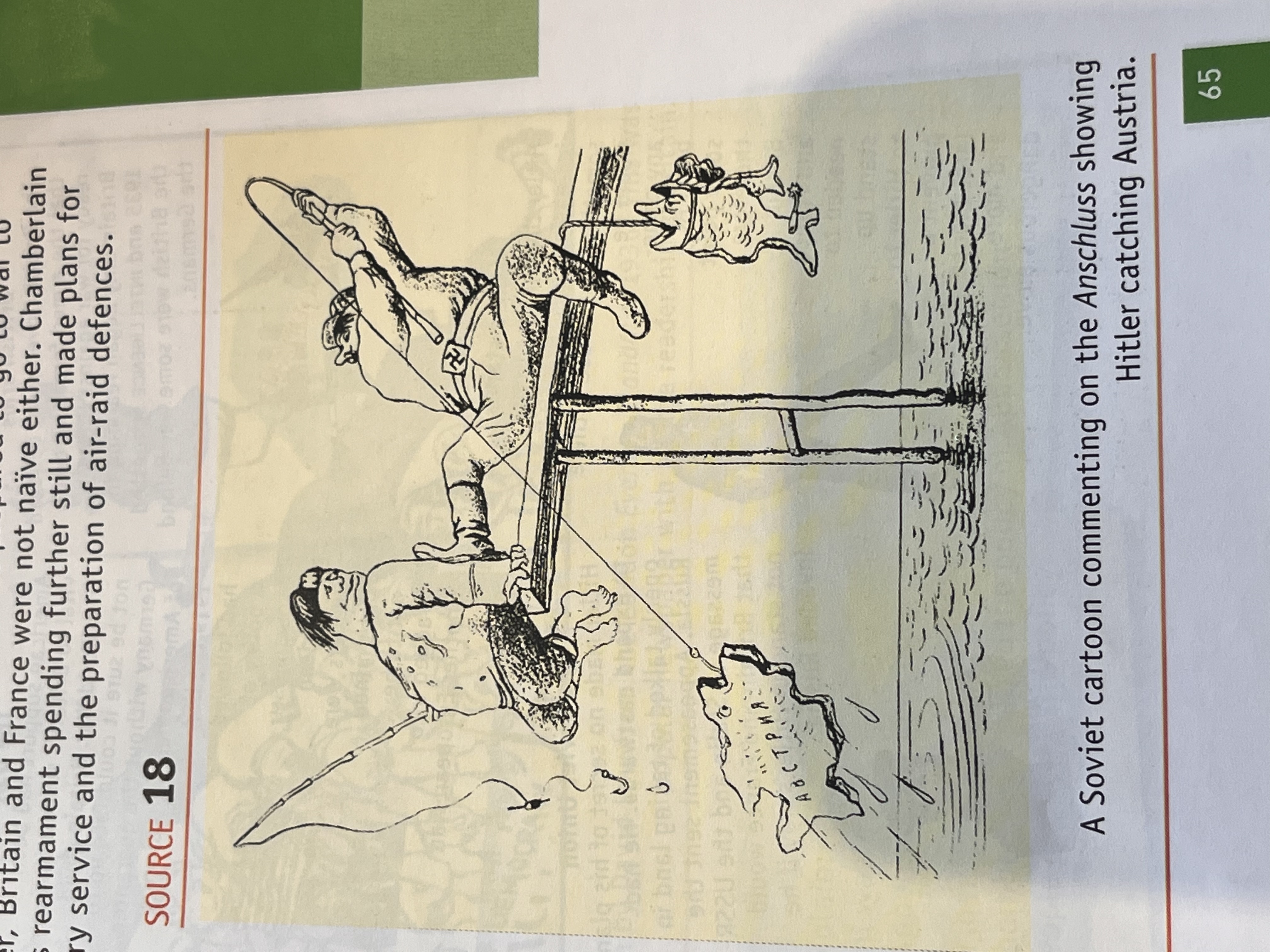
What is the message of this cartoon? (aka what message is the ^^cartoonist^^ trying to portray?)
* this cartoon shows Hitler’s aggression that he is prepared to go ‘deep fishing’ to get what he wants and that he doesn’t care about people. Hitler was land hungry and wasn’t going to stop at one fish or one piece of land.
* depicts Anschluss.
* depicts Anschluss.
5
New cards
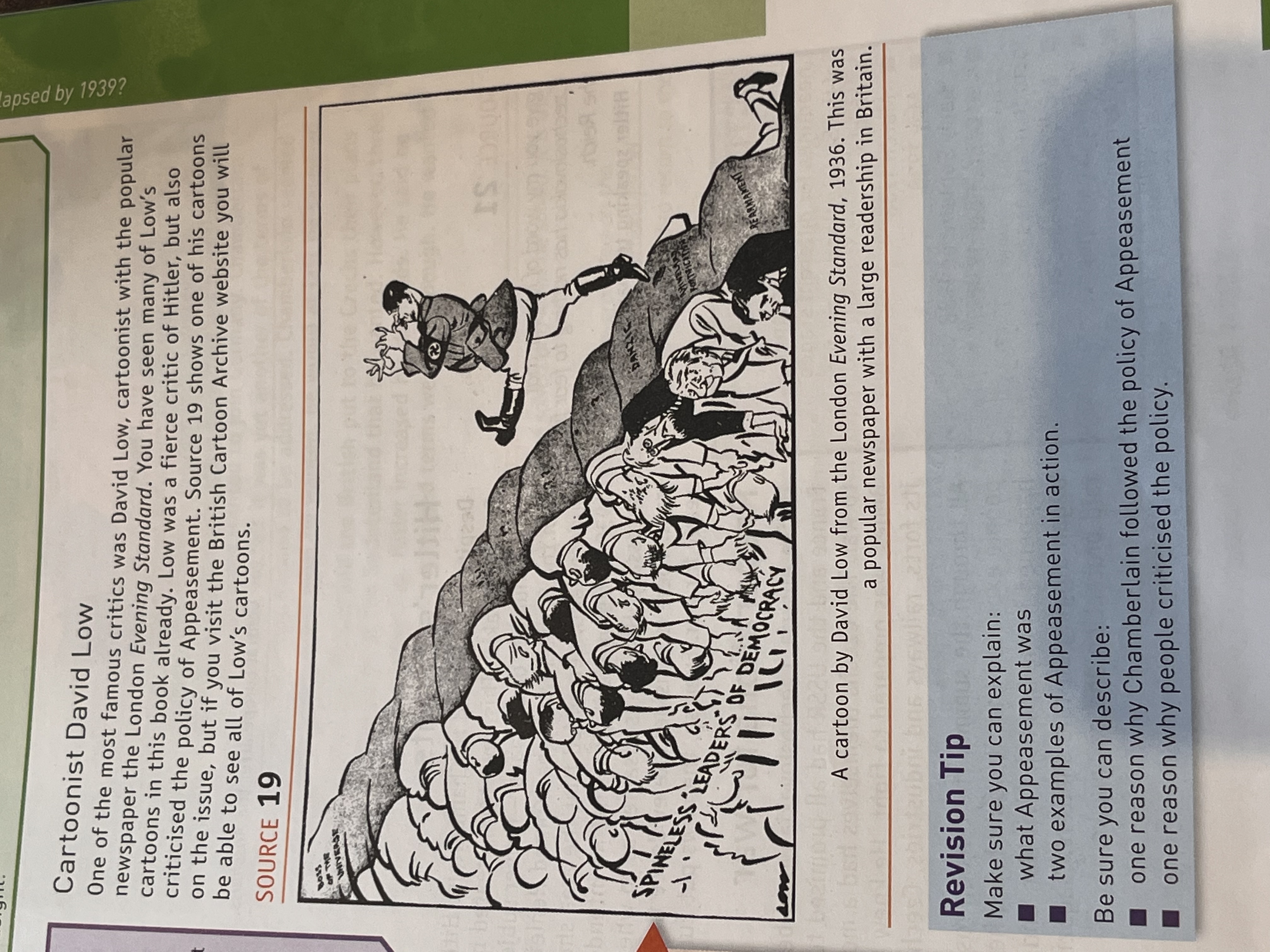
What is the message of this cartoon? (aka what message is the ^^cartoonist^^ trying to portray?)
* final destination is world domination
* low cartoon
* criticism of the leaders for not standing up to hitler - critical of appeasement
* hitler marching to his own tune as he violates versailles
* world leaders aren’t standing up they are shown as being spineless
* low cartoon
* criticism of the leaders for not standing up to hitler - critical of appeasement
* hitler marching to his own tune as he violates versailles
* world leaders aren’t standing up they are shown as being spineless
6
New cards
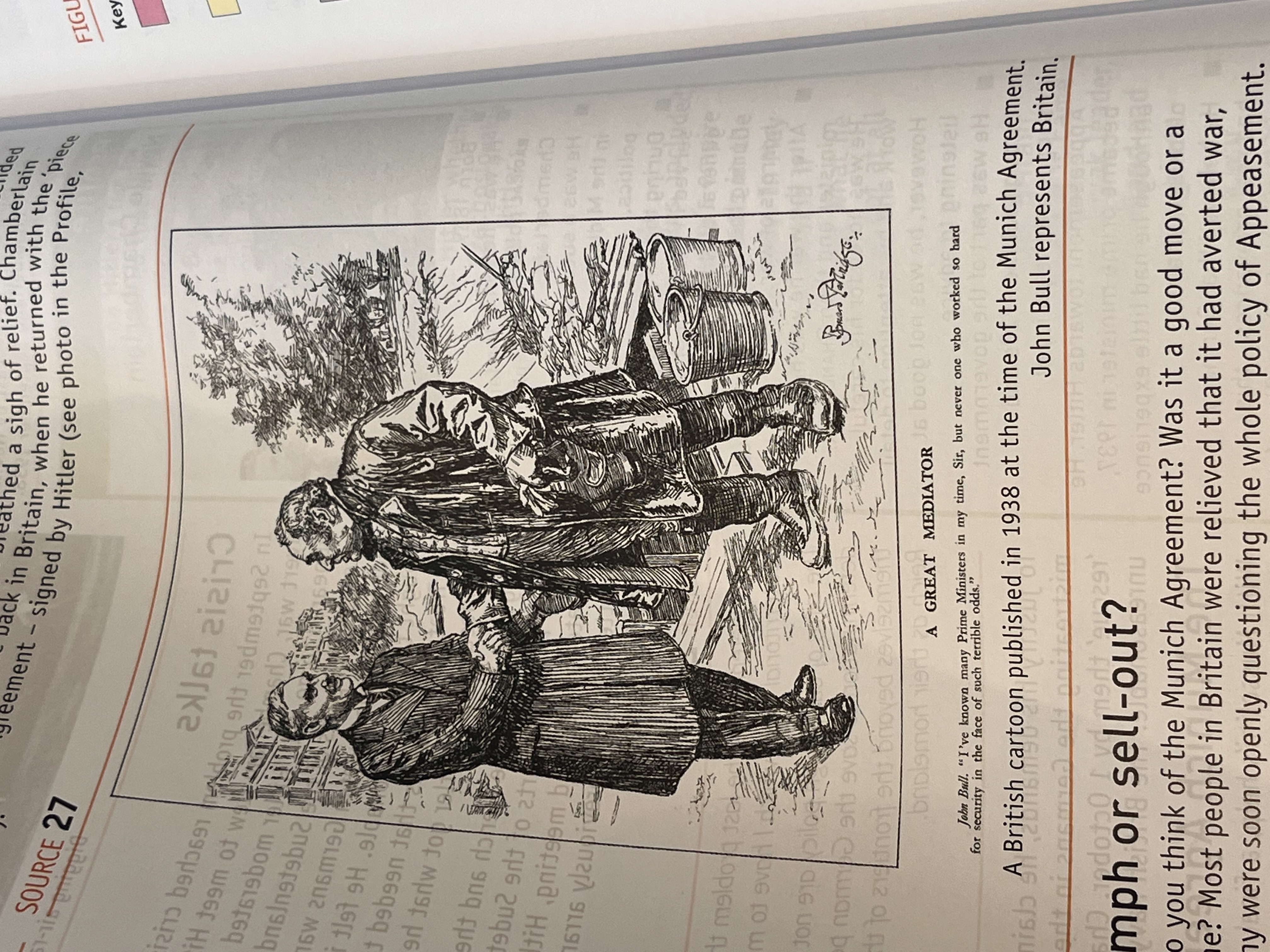
What is the message of this cartoon? (aka what message is the ^^cartoonist^^ trying to portray?)
7
New cards
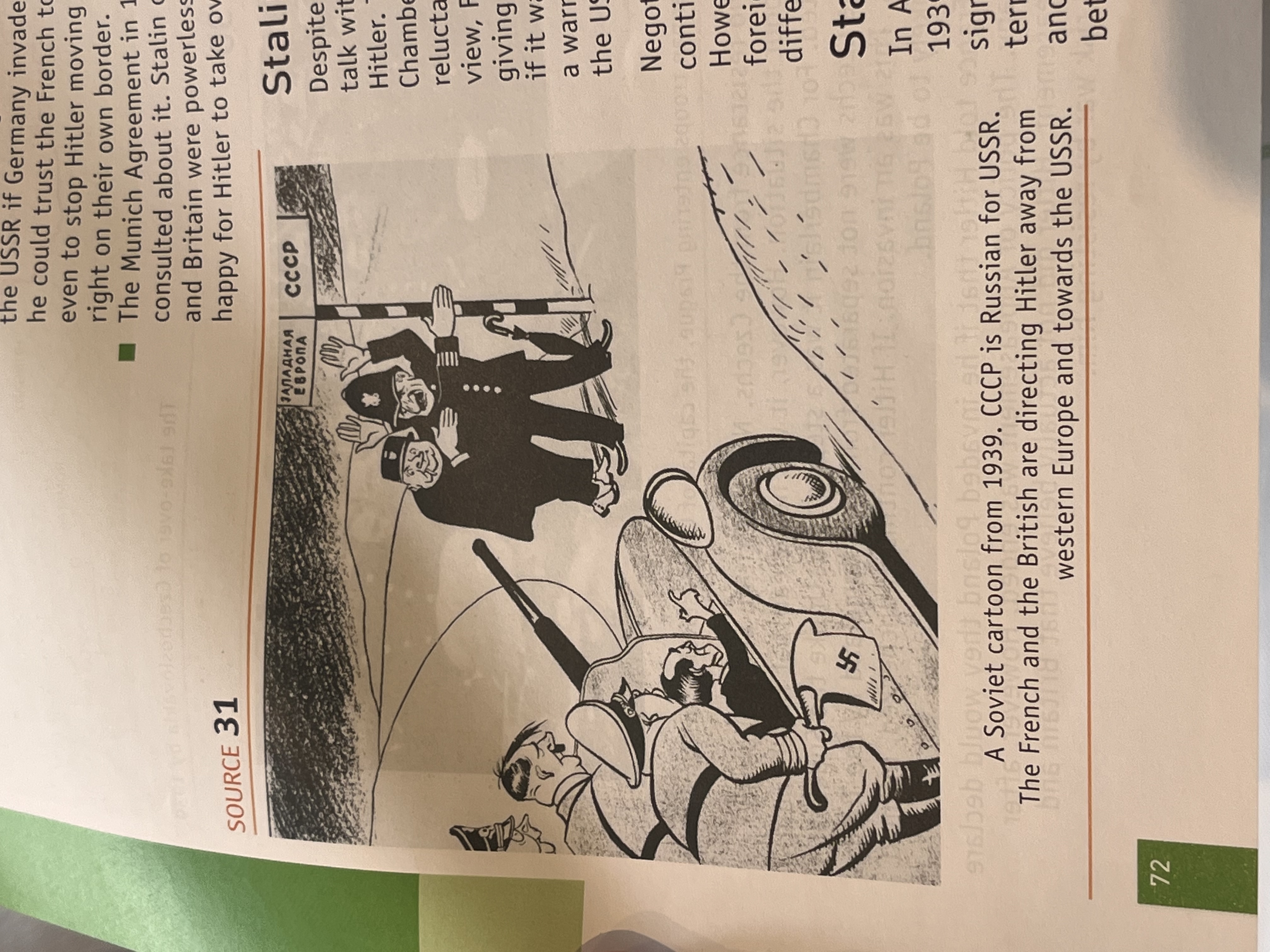
What is the message of this cartoon? (aka what message is the ^^cartoonist^^ trying to portray?)
8
New cards
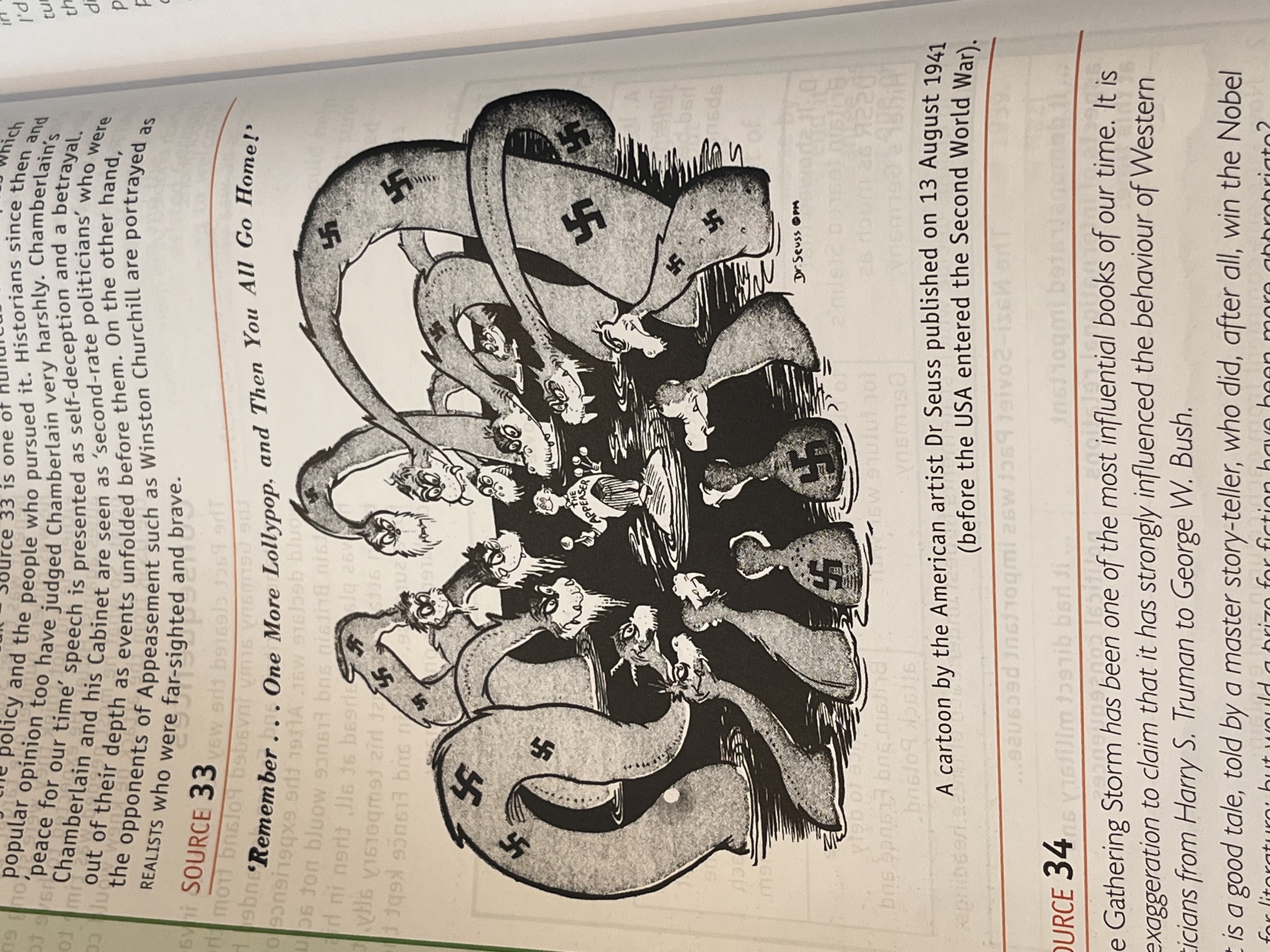
What is the message of this cartoon? (aka what message is the ^^cartoonist^^ trying to portray?)
9
New cards
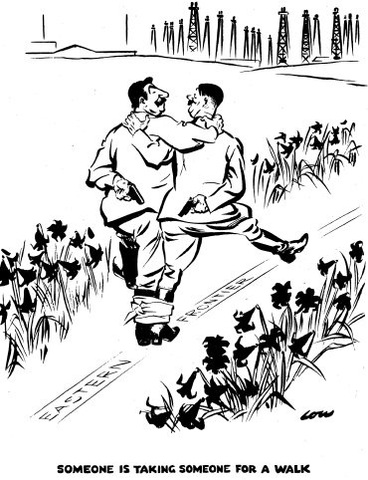
What is the message of this cartoon? (aka what message is the ^^cartoonist^^ trying to portray?)
* hitler and Stalin are meant to be friends, but both have a gun behind their back
* this cartoon is in reference to the nazi-soviet pact
* this cartoon suggests that the nazi-soviet pact did not mean they trusted each other.
* this cartoon is in reference to the nazi-soviet pact
* this cartoon suggests that the nazi-soviet pact did not mean they trusted each other.
10
New cards
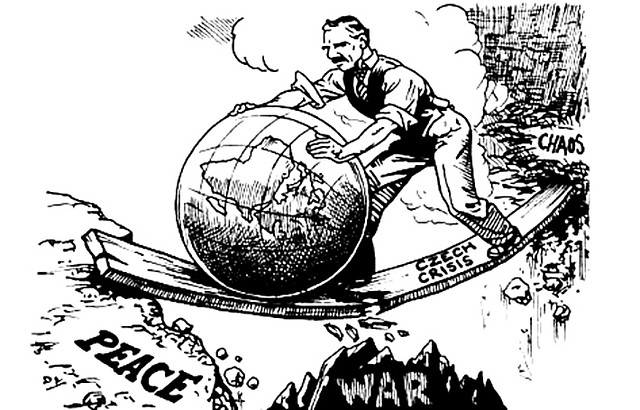
What is the message of this cartoon? (aka what message is the ^^cartoonist^^ trying to portray?)
* chamberlain is trying to push the world to peace, but could be endangering the world and we could end up in war.
* Chamberlain has his sleeves rolled up showing he is ready to work.
* The world just passed a crack suggesting that chamberlain might make it.
* Chamberlain has his sleeves rolled up showing he is ready to work.
* The world just passed a crack suggesting that chamberlain might make it.
11
New cards
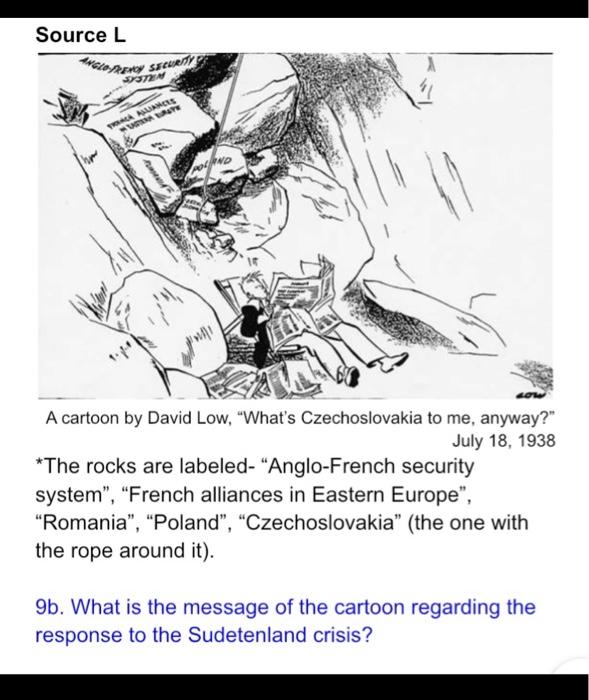
What is the message of this cartoon? (aka what message is the ^^cartoonist^^ trying to portray?)
* if Germany is allowed to take Czechoslovakia then eventually others will fail, including Britain and France.
* britain, looks laid back reading the paper, unaware of what is happening
* britain, looks laid back reading the paper, unaware of what is happening